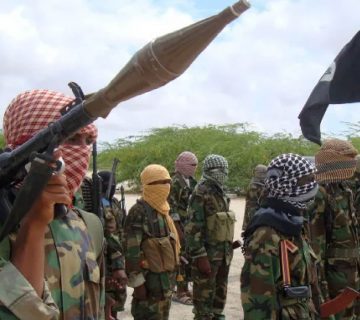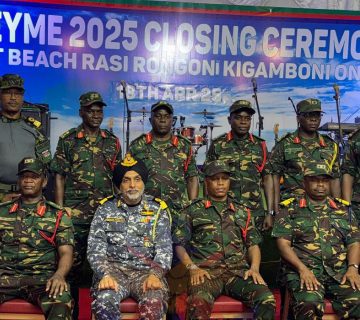Terrorists seem to make a score when checkpoints fail. On 14 October 2017, a truck reportedly loaded with several hundred kilogrammes of military-grade and homemade explosives passed through a government-controlled checkpoint at Sinka Dheer in Hodina district, about four miles outside Mogadishu. Mogadishu, Somalia’s capital, has been a war zone since the overthrow of Said Barre government in 1991. On suspicion that the truck was carrying explosives, Somalia security forces reportedly tried to stop the it, but the truck driver accelerated and crashed through a barrier leading to an explosion next to Safari Hotel. The Hotel is located near the government offices, and is popular with both locals and foreign guests. This explosion was compounded when a fuel tanker that was parked nearby exploded in the blast. The hotel collapsed, trapping many under its rubble. The Qatari embassy was severely damaged. Moments later, a second blast occurred in Madina district in central Mogadishu. The blasts claimed the lives of over three hundred people, and injured hundreds, making this the deadliest terror attack in Somalia since the Islamist al Shabaab group launched its insurgency in 2007.
The explosions exposed Somalia’s security vulnerabilities with key focus being the government checkpoints that have been mounted on all the entrances and exits of Mogadishu. Checkpoints, which control the movement of people, cars, and goods, also help to identify criminals and terrorists, locate bombs and contraband items. In this regard, checkpoints are useful for maintaining peace and security. The overthrowing of Barre created a power vacuum with various armed clan groups competing for influence and control of State resources. There was proliferation of lethal arms in Somalia, more so after United Nation Operation in Somalia (UNOSOM1) failed to establish ceasefire, and bring peace and stability in the country. What followed was politicized clan identity that was increased by the available weapons. The situation, coupled by youth unemployment, make the youth vulnerable and susceptible to the clan militia groups.
In 2000, a transitional government was established in the country. Four years later, Transitional Federal Government (TFG) was formed. This helped to reduce the intensity and the scale of the conflict. In 2006, the Ethiopian forces joined the conflict dismantling the Islamic Court Union (ICU). ICU was a clan-based system that was governed by Sharia law. Some members of the dismantled ICU formed radical groups notably the al-Shabaab group. This terror group has now been operating in Somalia, and sometimes make attacks beyond the Somali border. For instance, in September 2011, one British citizen was killed and another was kidnapped by al-Shabaab militants at a resort near the Kenyan- Somalia border. A month later, on October 2011, gunmen believed to be al-Shabaab militants kidnapped two female Spanish aid workers and shot their driver in a refugee camp in north eastern province of Kenya. The women worked for Medecins Sans Frontiers (MSF) which runs health centers for the more than 400,000 Somali refugees in Dadaab refugee camp. On 11 July 2010, suicide bombers believed to be al-Shabaab militia carried out an attack on crowds watching a screening of the 2010 FIFA world Cup final match in Kampala Uganda. The attack left 74 dead and 71 injured.
In response, Kenyan government initiated ‘Operation Linda Nchi,’ a military mission led by the Kenya Defence Force (KDF), to create a buffer zone between Somalia and Kenya. After successfully taking over all the al-Shabaab strong holds, the Kenyan troops were formally integrated to the African Union Mission in Somalia (AMISOM) that is an active regional peace keeping force operated by the Africa Union and approved by the United Nations. Ever since, al-Shabaab have been staging major attacks in Somalia and East Africa. For instance on 21 September 2013, al-Shabaab militia carried an assault on Kenya’s Westgate Mall. The attack left 61 people dead and hundreds injured. Two years later, heavily armed al-shabaab militia stormed Garissa University killing 148 people and injuring 79 people. However, the 14 October 2017 Mogadishu attack claimed the lives of over 300 people hundreds injured. This was the deadliest in its history.
Failures of government checkpoints can be attributed to different factors. Corruption. The country is also facing economic and financial challenges leading to low salaries and wages. Some government soldiers are then forced to look for alternative sources of income, making it necessary for them collaborate with the terror groups. Additionally, there is a possibility that illegal checkpoints have being mounted, with some of these being used to acquire bribes.
Internationally, government checkpoints have also had a share of challenges. It is alleged that most of them have had a history of being infiltrated and attacked. For instance, on 7 July 2017, an Egyptian government checkpoint in the North-Eastern Sinai Peninsulawn of Rafah was attacked leading to the death of 23 Egyptian government soldiers. The attackers arrived in 24 four wheel vehicles in the remote desert area in the village of el-Barth, South-West of the border town of Rafah. History shows that Israel has been attacked several times despite the country mounting several roadblocks and checkpoints. For instance in the month of October 2017, over 10 Israeli nationals have been killed and others severely injured by radical Palestinian Muslims. This despite Israel having 27 internal permanent checkpoints in the West Bank, 26 checkpoints in the Green Lane, 12 checkpoints in Hebron, and hundreds of physical road blocks in the West Bank. On Monday 9 October 2017, al Shabaab militants attacked a military checkpoint in the north-east of Somalia, at Bosaso, in Puntland, killing seven people (three policemen and four civilians), and injuring 13. It seems, therefore, that there is need to re-look the use of checkpoints in the management of security in and beyond Somalia.
A ban on the use of vans, truck, trailers, and other similar vehicles that ferry goods to and from densely populated areas could be one way to manage security in terror-prone locations. The ban could be blanket, and include all such vehicles in busy urban areas. It may also be time-sensitive, allowing the use of these vehicles only at night, for a few hours only. Security in these areas could be increased with random checks.
Another approach would be to mount random checkpoints that can be operationalized within 15 minutes of a security unit’s arrival on site. Numerous patrols effected in varying frequencies in areas prone to terrorist activity may help in the identification and/or interrogation of suspected criminals.
Ian Mwenda and Janice Sanya, Research Department, the HORN Institute.




Wow Thanks for this review i find it hard to locate extremely good specifics out there when it comes to this material appreciate for the blog post website